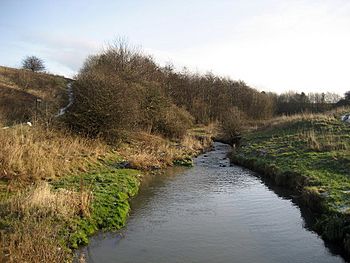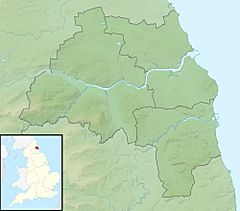River Don, Tyne and Wear facts for kids
Quick facts for kids River Don |
|
|---|---|

Don near Boldon Colliery
|
|
|
Location of the mouth within Tyne and Wear
|
|
| Country | England |
| County | Tyne and Wear |
| Physical characteristics | |
| Main source | Springwell |
| River mouth | River Tyne at Jarrow 54°59′10″N 1°28′20″W / 54.986114°N 1.472084°W |
| Length | 15.4 km (9.6 mi) |
| Basin features | |
| Basin size | 42.7 km2 (16.5 sq mi) |
The River Don is a cool waterway in North East England. It's about 15.4 kilometers (or 9.6 miles) long. This river is a branch, also called a tributary, of the much bigger River Tyne. It flows through the area known as Tyne and Wear.
Contents
The River Don: A Journey Through Tyne and Wear
The River Don might not be the longest river, but it plays an important role in its local area. It helps drain water from a basin that covers about 42.7 square kilometers (16.5 square miles). This means it collects water from a wide area around it.
Where Does the Don Begin and End?
Every river starts somewhere, and the River Don begins its journey near a place called Springwell. This is its source, where the water first gathers.
From Springwell, the river flows mostly east for about 6 kilometers (3.7 miles). After this eastern stretch, it makes a turn and starts flowing north. Its journey ends when it joins the River Tyne. This meeting point is in the town of Jarrow.
The Don's Path and Its Neighbors
As the River Don travels north, it passes under a structure called the Jarrow Bridge. This bridge helps people and vehicles cross over the river.
For a good part of its upper section, the River Don acts like a natural border. It separates two important local areas: Gateshead and the Sunderland. So, if you're walking along the river in some spots, you might be standing right on the line between these two places!
Why Is the River Don Important?
Even smaller rivers like the Don are vital for the environment and the communities around them. They provide a home for various plants and animals. Rivers also help manage water, carrying it from the land to larger bodies of water like the Tyne, and eventually to the sea. This helps prevent flooding and keeps the local ecosystem healthy.


